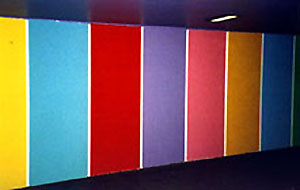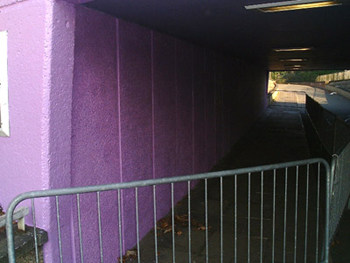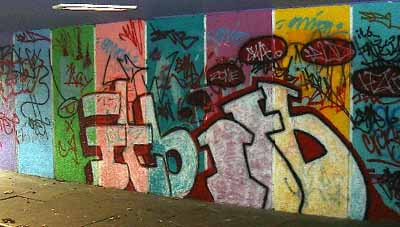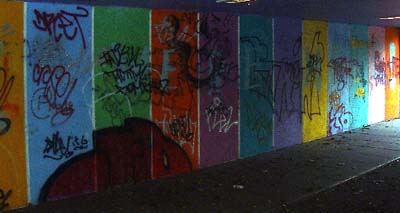Graffiti and the
Vansittart Road Underpass
A Puce Error!!!
December 2001

The brightly painted panels opposite The
Millennium Mural in the Vansittart Road Underpass. The above
photo was taken in September 1999 soon after the mural had been
completed. Now all this is lost following an ill-judged 'clean-up'
by RBWM.

Detail from the
Vansittart Road Underpass Mural.
For background please
see The Original Mural in 1999
See also Graffiti
in The Borough and
Vansittart Road Skate Park Home Page
Graffiti overpainted in
puce!
For many months the underpass beside the
Skate Park has been a disgrace. Borough claims that they are
fighting graffiti have been received skeptically by local residents
as weeks and months go by with little attention, although it
is true to say that back in August the mural itself received
some much needed cleaning with a protective coating applied that
wasa designed to facilitate the removal of any subsequent graffiti.
The point must be made, however, that if a treated wall is defaced,
the local residents still have to put up with the unsightly mess
until such time as the highly specialised equipment and treatments
required are used to remove it. This could easily mean a wait
of a good few weeks, with the graffiti getting progressively
worse daily.
Come December and action has finally been taken to remove months
of graffiti but local residents are furious.
Instead of the brightly coloured panels, illustrated above, that
complemented the mural itself, the Borough have elected to paint
the entire side of the underpass in one seriously unfortunate
shade of puce! The Borough have also decided to apply a costly
anti-graffiti coating to this unfortunate choice of decor. Apparently
this specially prepared paint is intended to match the Royal
Borough's letterhead...

Throughout 2001 this wall had been increasingly
heavily attacked by vandals and even the photographs below (taken
in November 2001) do not fully show the appalling state of the
underpass when action was finally taken this week.


Disorganised Graffiti
Removal
Regretably this matter has highlighted
the disorganised nature of graffiti removal in the Royal Borough.
Apparently there is no fixed contract for this kind of work in
Windsor although the problem is a serious one. We hear that the
Borough has attempted to counter the problem by requesting contract
landscape gardeners to clean the swings and childrens' roundabouts,
etc. whilst ill-equipped and untrained council staff are also
expected to do what they can. Unfortunately they are unfamiliar
with the specialised chemicals required for the many different
surfaces upon which graffiti is sprayed. These include glass,
plastics, paint and brickwork. It means therefore that an incorrect
treatment can make matters worse.
An 'ad hoc' arrangement that WMBC has with Abelclean of Reading
is doubtless insufficient. There is no specific contract with
the company and so regular, consistent and effective attention
to the problems of graffiti fail to be provided.
Windsor residents believe that despite press announcements that
the problem is considered of the highest priority and that reported
graffiti will be removed within days, the fact of the matter
is that there is no regular or full-time facility to achieve
this stated aim. We think there should be. We also think that
a concerted effort must be made to identify those responsible,
which has not been effectively implemented to date. Without such
action, the problem will continue to grow, the town will become
increasingly unsightly, and the costs of removal will spiral.
The Observer reports 'Increased
Pressure on Graffiti Vandals'
In this week's edition of the Observer, 14th December 2001, it is reported
that special mural sites are to be set up where graffiti will
be permitted. Cllr. Derek Wilson is reported to support the idea,
saying "They could do artistic mural painting as opposed
to simple spraying whatever they want." Mr Wilson is hoping
to reduce the amount of mindless graffiti by aiming their artistic
talent towards a programme that is better for the community.
It has also been announced that graffiti vandals wil be required
to clean up after themselves, but judging by the struggle that
the professionals have, even on treated areas such as the Mural
at Vansittart Road Underpass, the vandals will have their work
cut out...
... on the other hand, perhaps not, as
there has not been one single arrest in the past year.
UPDATE 21.12.01
The Windsor Observer "Lilac
Whine"
Further to the above, The Windsor Observer,
on 21st December 2001 (p. 3) published a news item under the
heading 'Lilac Whine' which implied that all was well and that
a local resident's complaint about the colour selection was just
a 'whine'. The overall impression was therefore given that the
Borough had acted and chosen wisely.
Thamesweb have answered as follows:
|
The article on page 3 of the Windsor Observer,
whilst headed by a jolly amusing pun on wine, does not reflect
the real point about the Borough's effectiveness in combatting
graffiti in the Borough.
The Observer has reported quite regularly in the last year concerning
the Borough's efforts to tackle the problem of graffiti, but
there is precious little evidence of any improvements to date.
The shortcomings include:
No permanent contract with professional removal
teams.
Seemingly no success in identifying or prosecuting those responsible.
A dismally slow response time in cleaning up reported instances.
Treatment of vulnerable areas with an anti-graffiti coating to
aid removal - but from which reported graffiti is not removed
for weeks, if not months!
A published 'Graffiti Line' phone number that has changed at
least once, and which does not actually get directly through
to the individual responsible for organising graffiti removal.
Contract gardeners asked to clean graffiti from play areas, and
council staff too, equipped with just the odd tin of cleaning
chemicals which are often not appropriate for the type of clean-up
required.
The efficacy of providing 'legal' graffiti areas as reported
recently are unproven. The British Transport Police in their
studies on the problem have taken the view that they are undesirable
on three counts: 1. They generate graffiti in neighbouring areas;
2. Breed new offenders; and 3. Provide an excuse for carrying
paint spray cans when challenged elsewhere (BTP, internal memorandum,
1990).
Res idents can raise little enthusiasm for
the work that the Borough initiated at Vansittart Road underpass
for a variety of reasons. In September 1999 an excellent job
was done in complementing the Oakbridge Millennium Mural on one
side with brightly painted coloured panels opposite and throughout
the length of the underpass, a project that was applauded by
all those that walked by. It obviously generated a good deal
of respect from the graffiti vandals too because it was many
months before serious graffiti attacks commenced. These subsequent
attacks came about because the initial, comparatively insignificant,
attacks were not removed promptly so it became 'fair game'.
Now we have one giant, puce-coloured canvas for which the vandals
have no respect at all. So little respect, in fact, that the
new puce paint was vandalised on the very first day of the clean-up,
actually before the work was even completed! Now, one week later,
the vandals are back, the panels being attacked towards the end
of the day on Thursday 20th December. This matter has been reported
to the Borough. We wait and see how long it takes before the
scrawls are removed.
The time-scale between graffiti attacks and their removal is
important. Quite apart from residents having to put up with its
unsightliness for months, the vandalism is legitimised if the
vandals see no interest in, or attempts at, cleaning away and
removing the eyesore.
The Royal Borough spokesman, when claiming that the single colour
at Vansittart Road underpass was selected to facilitate repainting,
ignores the fact that no repainting is now possible because an
anti-graffiti coat has been applied to this ghastly puce canvas,
totally wasting the time and costs expended creating the original,
multi-coloured panels.
Residents' 'beef' is that the Borough didn't choose to protect
their original investment in the high quality, genuinely more
attractive colour scheme, choosing to destroy it after little
more than two years, in the interest of financial economy, with
scant regard for its attractiveness. In the absence of any attempts
to combat the causes of graffiti, or to identify the perpetrators,
this 'economy' will doubtless prove false as the endless clean-up
costs spiral. These costs can admittedly be pruned by not bothering
to clean off the graffiti for months on end.
So be it, this a 'whine'. Nevertheless we wish all the staff
at the RBWM, our councillors, and The Observer a very Merry Christmas
and Happy New Year...
|
|



